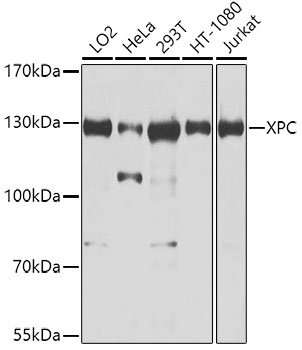XPC antibody
GTX70308
ApplicationsWestern Blot
Product group Antibodies
ReactivityHuman
TargetXPC
Overview
- SupplierGeneTex
- Product NameXPC antibody
- Delivery Days Customer9
- Application Supplier NoteFor WB: Load 40ug cell lysate/lane. Use at a dilution of 1:500-1:1000. Optimal dilutions/concentratons should be determined by the researcher.
- ApplicationsWestern Blot
- CertificationResearch Use Only
- ClonalityPolyclonal
- Concentration0.5 mg/ml
- ConjugateUnconjugated
- Gene ID7508
- Target nameXPC
- Target descriptionXPC complex subunit, DNA damage recognition and repair factor
- Target synonymsRAD4, XP3, XPCC, p125, DNA repair protein complementing XP-C cells, mutant xeroderma pigmentosum group C, xeroderma pigmentosum, complementation group C
- HostRabbit
- IsotypeIgG
- Protein IDQ01831
- Protein NameDNA repair protein complementing XP-C cells
- Scientific DescriptionThe protein encoded by this gene is a key component of the XPC complex, which plays an important role in the early steps of global genome nucleotide excision repair (NER). The encoded protein is important for damage sensing and DNA binding, and shows a preference for single-stranded DNA. Mutations in this gene or some other NER components can result in Xeroderma pigmentosum, a rare autosomal recessive disorder characterized by increased sensitivity to sunlight with the development of carcinomas at an early age. Alternatively spliced transcript variants have been found for this gene. [provided by RefSeq, Aug 2017]
- ReactivityHuman
- Storage Instruction-20°C or -80°C,2°C to 8°C
- UNSPSC12352203
References
- Boucher D, Kariawasam R, Burgess J, et al. hSSB2 (NABP1) is required for the recruitment of RPA during the cellular response to DNA UV damage. Sci Rep. 2021,11(1):20256. doi: 10.1038/s41598-021-99355-0Read this paper



